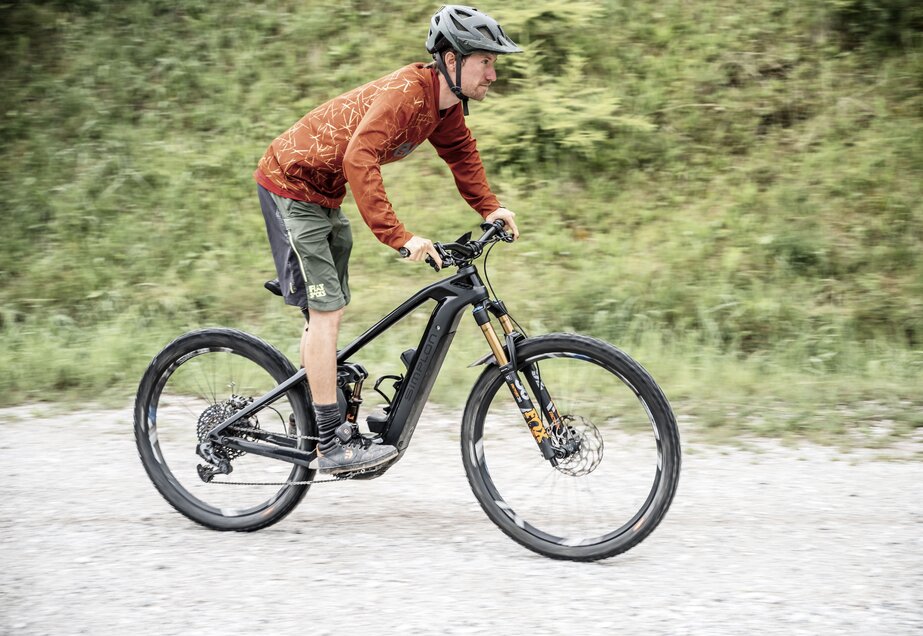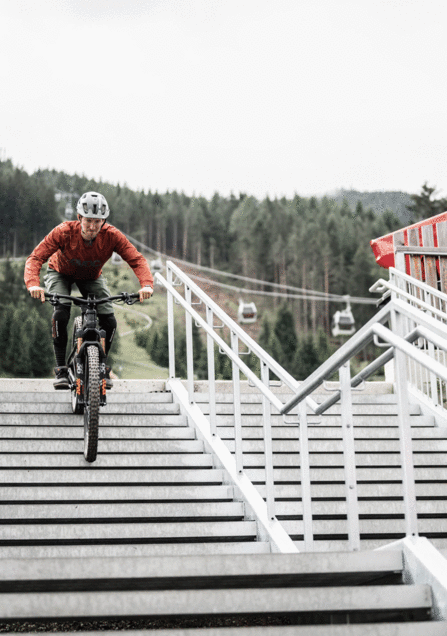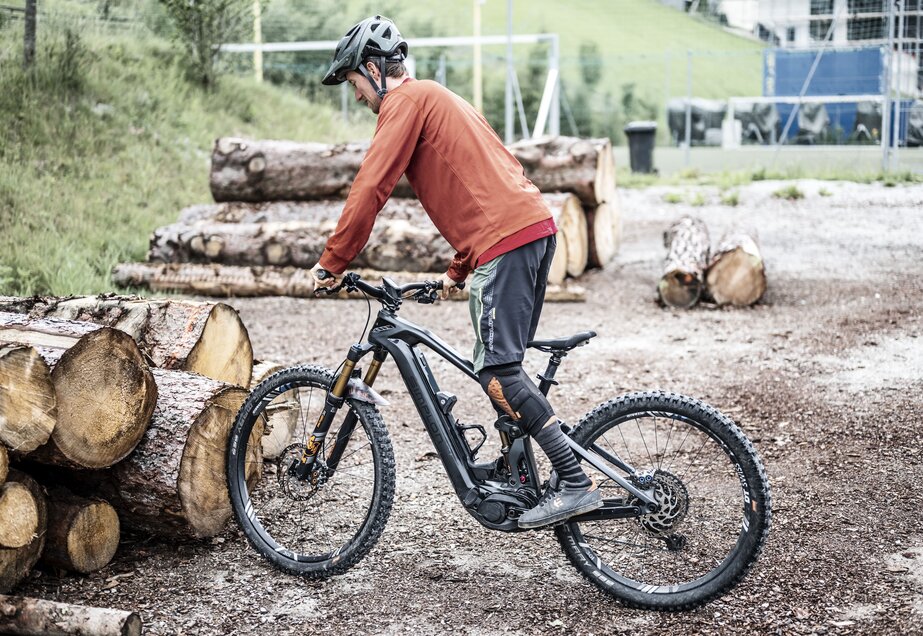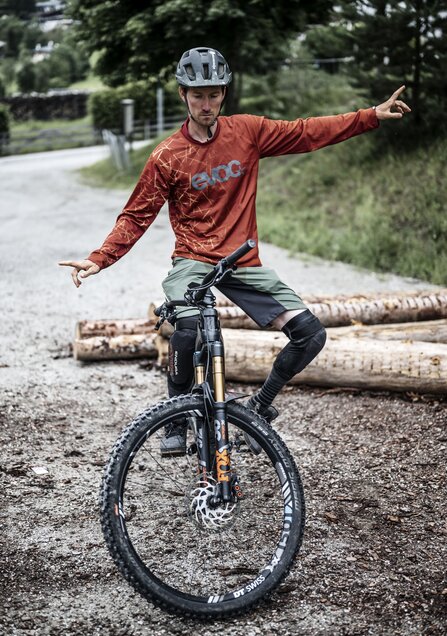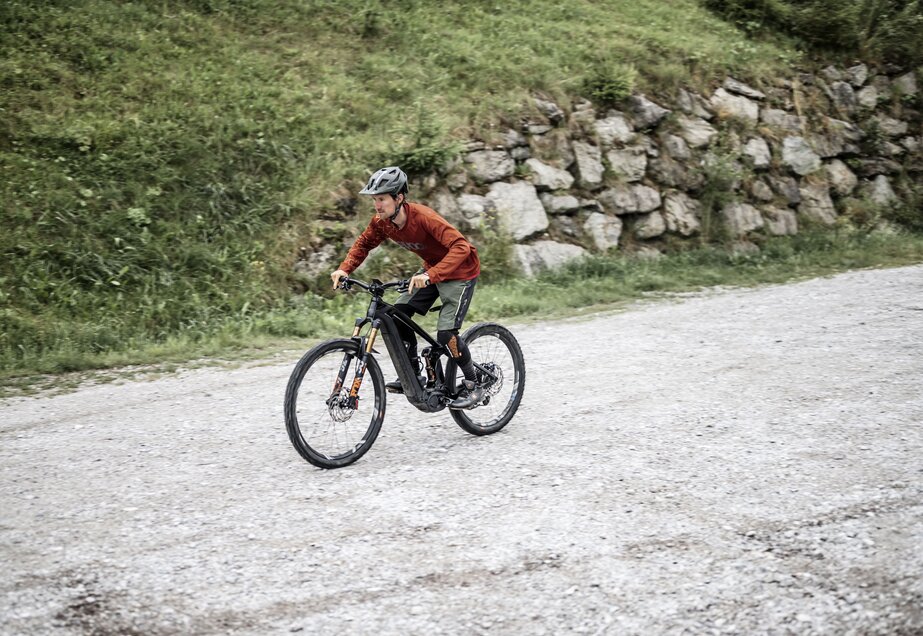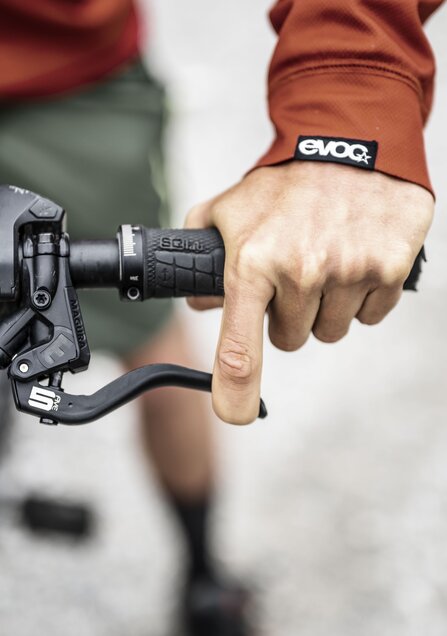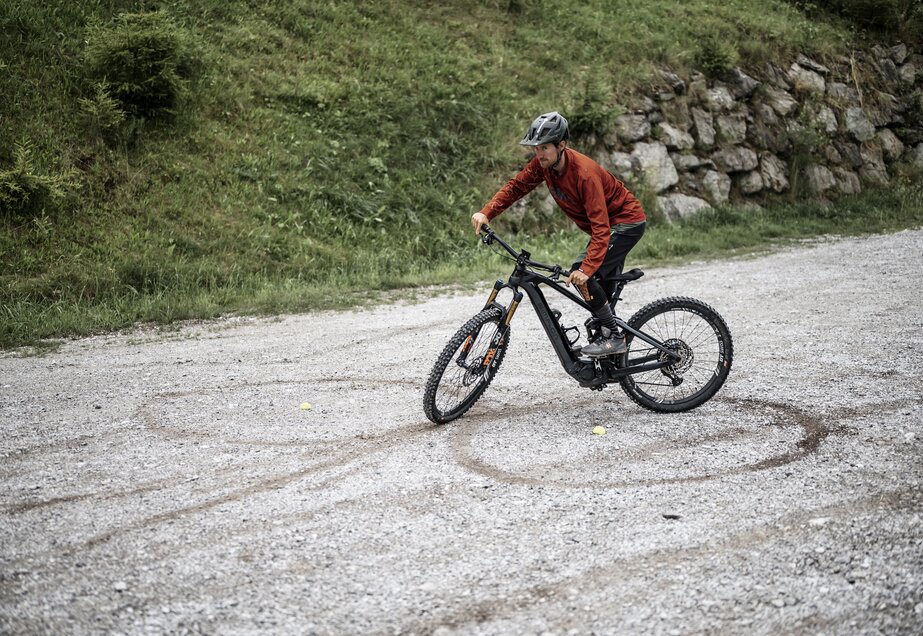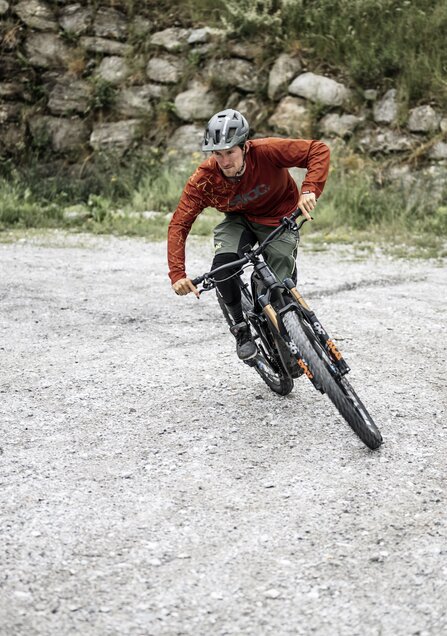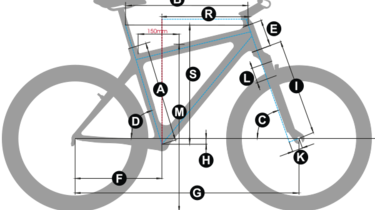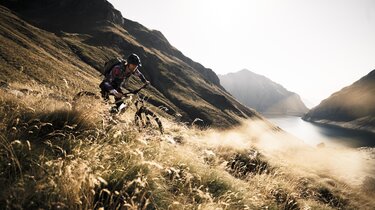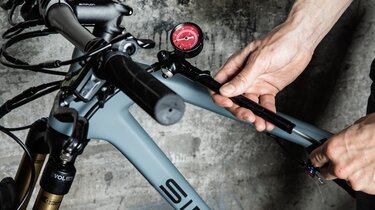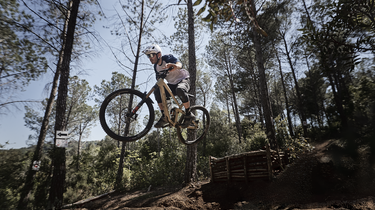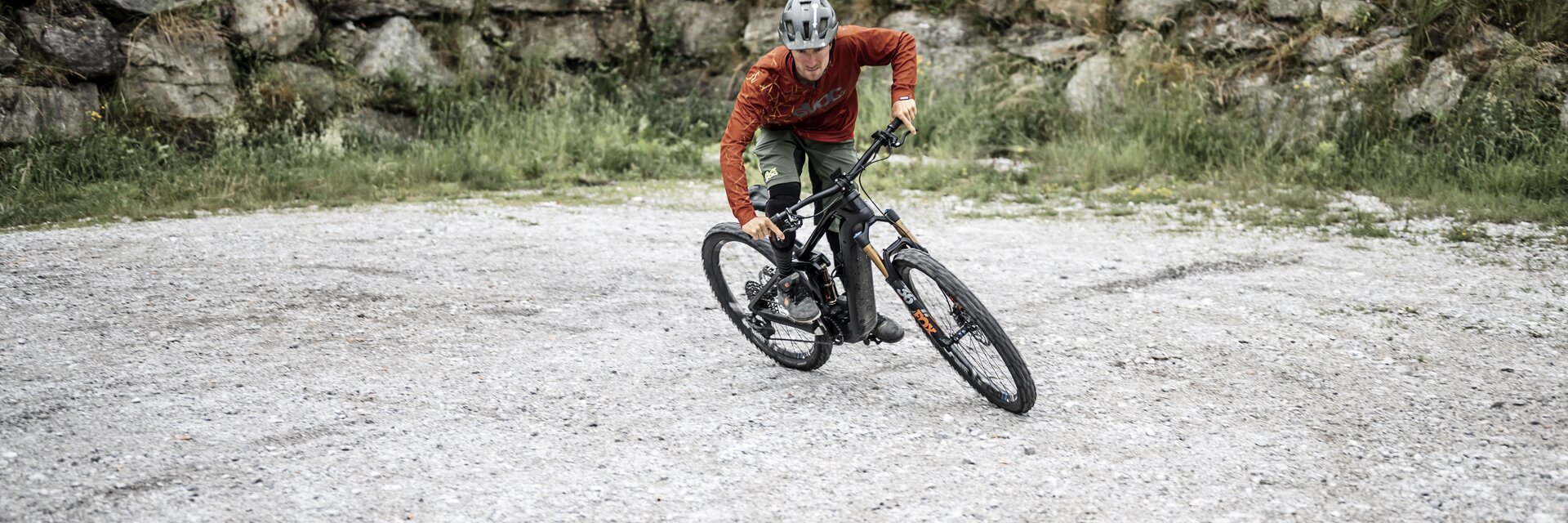

MTB technique – tips, tricks, drills and exercises
Learn how to master your MTB riding technique: the right basic position, proper gaze control, effective braking, cornering skills, tackling obstacles safely & more. Improve your MTB skills now!
Do you want to be safe and confident on your mountain bike?
The right MTB riding technique is the key! Whether you want to master tricky root passages, ride tight bends cleanly or conquer steep uphills - with the right technique, you'll have even more fun on the trail. We have put together practical MTB tips, valuable advice and simple exercises for beginners and anyone who wants to improve their skills. This will teach you safe braking, the right posture and optimum bike control - for more flow and control on any terrain!
How do I find the right basic position when mountain biking?
The basic position is the foundation of mountain biking. It forms the basis for all other riding techniques and ensures better control, stability, and safety on the trail.
- Pedals horizontal – for maximum stability and control.
- Center of gravity directly above the bottom bracket – for optimal balance.
- Stay relaxed! Arms and legs are slightly bent.
- Elbows outwards (“gorilla position”) – for greater mobility.
- Upper body flat, back almost horizontal – improves bike control.
- Index finger on the brake levers – for quick reactions.
- Look ahead – two seconds in front – helps to spot obstacles early.
- “Front low, back high” – the legs are more extended than the arms.
- “Heavy feet, light hands” – put weight on your feet, don’t grip the handlebars!
Why is the basic position so important?
Without a stable starting position, you will quickly lose control of your bike – especially on technical trails, in corners, or on rooty sections. If you don’t position yourself correctly, you risk falling and unnecessarily losing power.
What are the most common mountain bike riding mistakes and how do you avoid them?
- Stretched arms: If your arms are overly stretched, you often find yourself in a “scared position.” The downside: You can't apply enough pressure to the front wheel, making maneuvering more difficult and reducing control.
- X-knee: This knee position makes it harder to maneuver your bike and affects your riding technique. Make sure your knees aren't pointing inward too much.
- Incorrect weight distribution when descending: On steep descents, the center of gravity often shifts too far forward, which restricts movement and misaligns your hips. The right approach: On steep descents, the center of gravity should be shifted back. Make sure to properly push the bike underneath your body when transitioning from flat to steep sections.
Good to know: The center of gravity should always be adjusted to the terrain. Shift it back on steep descents and forward on flat sections!
How do you improve your balance when mountain biking?
Good balance is essential when mountain biking off-road. Whether you're riding uphill or downhill, crossing roots and rocks, or navigating tight turns, good balance helps you control your mountain bike better and ride more safely on the trail.
With these targeted riding technique exercises, you can improve your balance step by step:
- Balance with your front wheel against a wall – this will strengthen your sense of balance.
- Balance with your front wheel against a small obstacle (e.g., a tree trunk) – this improves coordination and control.
- Shift your center of gravity on a slight incline – focus on pedal pressure (this can be a bit more challenging for beginners).
- Keep your balance on flat terrain – with the front wheel turned!
You can also increase the difficulty of these exercises by trying them one-handed, hands-free, sitting, standing, or with the front wheel straight. The most important thing: Repeat the exercises regularly to develop a better feel for your mountain bike and the terrain.
How do you brake properly when mountain biking?
Tips for Using the Front and Rear Brakes
Now that you’ve mastered the basic position and have control over weight transfer, it’s time to focus on braking correctly off-road. The right braking technique is crucial for your control and safety on the trail. Place your index finger on each brake lever – for both the front and rear brakes – and operate them simultaneously. This will increase the braking power and shorten your stopping distance.
The Front Brake
The front brake is much more effective than the rear brake. If your center of gravity is too far back while braking, the front wheel can slip. On the other hand, if the center of gravity is too far forward, there’s a risk of flipping over. When braking with the front brake, it’s important to maintain body tension so that your center of gravity stays in the right position and doesn’t shift forward.
Exercise with the Front Brake:
Brake using only the front brake. Start slowly, then gradually increase your speed while continuing to brake with the front brake. Afterward, compare the braking distance to that of the rear brake to better understand the braking force.
The Rear Brake
On flat stretches, it is often sufficient to use only the rear brake — but always with caution. Braking too hard with just the rear brake can quickly cause the rear wheel to slip or lock up.
Practice with the Rear Brake:
Try to come to a quick stop without locking up the rear wheel. Practice this on different surfaces to develop a better feel for the rear brake and avoid slipping.
How do you ride correctly in curves and tight corners when mountain biking?
Tips for cornering technique at low speed
Cornering while mountain biking can be challenging at first, as the sequence of movements is complex. As a beginner, you should not head straight off-road, but rather practice on flat tarmac. With enough space on both sides, you can most easily learn the basics of cornering. The most important elements are always your line of sight and balance.
Here’s how to navigate bends and tight corners correctly:
- Adjust your speed: Slow down before the bend to maintain control.
- Line of sight: When entering a bend, look towards the exit to choose the ideal line early.
- Steering: At low speeds, you mainly control the bend by turning the handlebars.
- Leg position: Inside arm should be slightly bent, while the outside arm is more bent. Your legs work oppositely: the outside knee is slightly bent, while the inside knee is more bent.
- Centre of gravity: Your centre of gravity should stay centered over the bike, allowing you to apply more pressure to both wheels and remain more stable in the bend.
Exercise for better cornering:
Practice riding figure eights with increasing tightness, limiting the turns to the outside. The next level would be riding figure eights on a slight incline to further improve your cornering technique.
How do you master cornering on a mountain bike at high speed?
At higher speeds, you can no longer master bends just by steering or turning in. Instead, you need to lean or push the bike into the bend. The difference between ‘leaning’ and ‘pushing’ is that when leaning, the body and bike remain aligned on the same axis. If you have very good grip, you mainly lean the bike, whereas pushing is much more common in mountain biking.
The body position when ‘pushing’:
- Your body stays upright as you push the bike into the corner, with the outside pedal remaining down.
- The inner arm is more extended than the outer arm, and both elbows point outward.
- Your upper body is low, with your head turned toward the outside handlebars and your gaze focused on the bend.
- The outer knee presses inward against the frame, while your hips rotate in the direction of the bend.
- The outer elbows lean outward, initiating the rotation of the upper body into the bend.
- The weight is evenly distributed on both wheels.
Practice, practice, practice! If you're still searching for the perfect mountain bike or e-mountain bike to improve your skills, you'll find the right model at SIMPLON. Get your bike and get ready to take your riding technique to the next level!

